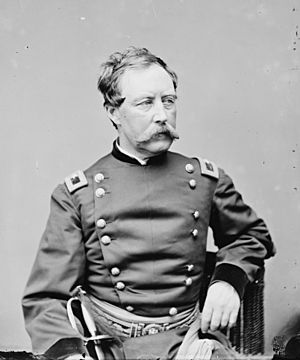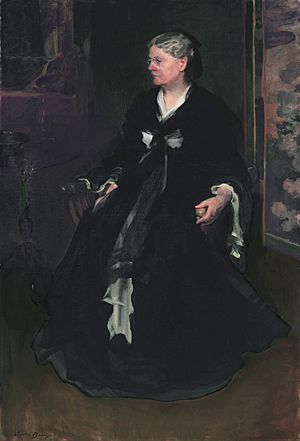Albion P. Howe facts for kids
Quick facts for kids
Albion Parris Howe
|
|
|---|---|
 |
|
| Born | March 13, 1818 Standish, Maine |
| Died | January 25, 1897 (aged 78) Cambridge, Massachusetts |
| Place of burial |
Mount Auburn Cemetery,
Cambridge, Massachusetts |
| Allegiance | United States of America Union |
| Service/ |
United States Army Union Army |
| Years of service | 1841–1882 |
| Rank | |
| Commands held | 2nd Division, VI Corps Artillery Depot, Washington, D.C. 4th U.S. Artillery |
| Battles/wars | Mexican–American War American Civil War |
Albion Parris Howe (born March 13, 1818 – died January 25, 1897) was an American soldier. He became a general in the Union Army during the American Civil War. He had some disagreements with his commanders. This eventually led to him losing his command of a division.
Early Life and Military Career
Howe was born in Standish, Maine. He studied at the United States Military Academy. He graduated from West Point in 1841.
After graduation, he served in the 4th U.S. Artillery. He also taught math at West Point for three years.
Howe fought in the Mexican War. He was recognized for his bravery in 1847. He earned a special promotion to captain for his actions near Mexico City. This included battles like Contreras and Churubusco. Later, he served under Robert E. Lee during the John Brown incident at Harpers Ferry.
Civil War Service
When the Civil War began, Howe served under George B. McClellan in western Virginia. He later took command of a brigade during the Seven Days Battles. He was promoted to brigadier general in June 1862.
Howe's troops fought in many important battles. These included the Battle of South Mountain and the Battle of Antietam. He then led the 2nd Division of the VI Corps. He led them at the Battle of Fredericksburg.
His division was heavily involved in fighting near Fredericksburg. This happened during the Chancellorsville Campaign. Howe's division also helped scout for the Union army in June 1863. This was to see if the Confederate army was moving.
Howe's division arrived late at the Battle of Gettysburg. His two brigades were sent to different parts of the battlefield. This left him without a direct command during the main fighting. After Gettysburg, his division fought near Funkstown, Maryland.
Howe continued to lead his division in other campaigns. These included the Bristoe Campaign and the Mine Run Campaign.
However, Howe was later removed from his command. He had disagreements with his corps commander, John Sedgwick. He also supported Joseph Hooker after the Union defeat at Chancellorsville. These issues likely led to his removal. Howe later spoke to a committee in Congress about these events.
After leaving the Army of the Potomac, Howe was put in charge of the artillery depot in Washington, D.C.. He briefly returned to the field at Harpers Ferry. This was to stop a Confederate attack on Washington.
After the War

After the war ended, Howe was part of the honor guard for Abraham Lincoln's body. He also served on the group that tried the people involved in Lincoln's assassination. He did not publicly comment on the trial's outcome.
Howe also worked with the Freedmen's Bureau in 1865. This organization helped formerly enslaved people. He left volunteer service in July 1866.
Howe retired from the Army on June 30, 1882. He held the rank of colonel. He passed away in Cambridge, Massachusetts. He is buried in Mount Auburn Cemetery there.
Howe was married to Elizabeth Mahaffey. They had six children together.

